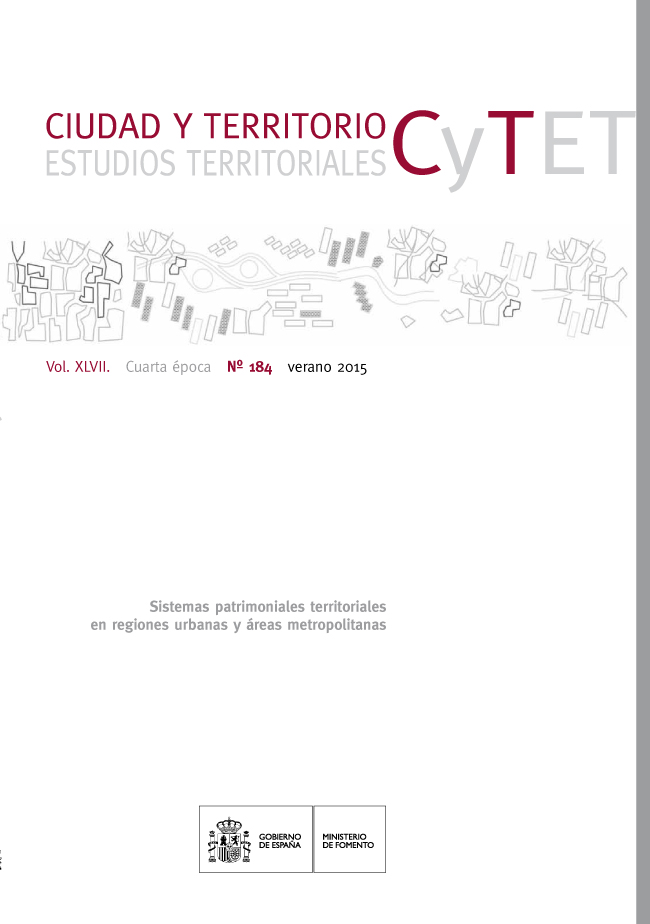Territory and Heritage systems: The Madrid urban region
Keywords:
Terriotorial heritage, heritage system, protected territory, Autonomous Region of MadridAbstract
This paper, within the framework of the debate on the dimensions and functions of the
“spatial heritage system” and the “protected spatial heritage” in urban regions, sets forth
arguments to understand the role of the natural, cultural and landscape heritage, as a whole, while
also highlighting how fundamental it is in order to build another development model, as it is the
basis of natural and social life, and stressing the importance of its role in tourism, the environment,
the landscape and local culture.
Second, an assessment is made of the role assigned to heritage in spatial-planning instruments
tested in the autonomous regions of Madrid, Castile and León, and Castile–La Mancha, where
priority has been given to a protectionist sector-based approach and there is a large gap between
theory and practice.
Third, the spatial-heritage system in the urban region of Madrid is mapped and analysed, showing
it strong presence in the territory, with 40% of the area being “protected territory”. The natural
heritage has a strong nature network affecting 34%, four biosphere reserves, 14 parks and 27
reserves and natural monuments. The cultural heritage has 1,177 BICs (assets of cultural interest),
noting the strength of Madrid and the existence of 63 historical complexes, seven of which are on
the World Heritage List, to make up a strong network that incorporates other types of heritage;
there are also 17 festival of national and international interest for tourism. The landscape, which is
weakly protected (only the Aranjuez “cultural landscape”, which is included on the World Heritage
List), is diverse, with almost all the landscape units of inland Spain present, as we see with 16,410
km of cattle tracks. A rich heritage which, because of its value and spatial significance, should be
an asset which, planned according to the logic of complementarity, allows an urban region to be
built that is polycentric, balanced and sustainable.
Downloads
Downloads
Published
How to Cite
Issue
Section
License
Copyright (c) 2015 Miguel Ángel Troitiño Vinuesa, Libertad Troitiño Torralba

This work is licensed under a Creative Commons Attribution-NonCommercial-NoDerivatives 4.0 International License.
Considering the provisions of the current legislation on Intellectual Property, and in accordance with them, all authors publishing in CyTET give -in a non-exclusive way and without time limit- to the Ministry of Transport, Mobility and Urban Agenda the rights to disseminate, reproduce, communicate and distribute in any current or future format, on paper or electronic, the original or derived version of their work under a Creative Commons Attribution-NonCommercial-NoDerivative 4.0 license International (CC BY-NC-ND 4.0), as well as to include or assign to third parties the inclusion of its content in national and international indexes, repositories and databases, with reference and recognition in any case of its authorship.
In addition, when sending the work, the author(s) declares that it is an original work in which the sources that have been used are recognized, committing to respect the scientific evidence, to no longer modify the original data and to verify or refute its hypothesis. Author(s) also declare that the essential content of the work has not been previously published nor will it be published in any other publication while it is under evaluation by CyTET; and that it has not been simultaneously sent to another journal.
Authors must sign a Transfer of Rights Form, which will be sent to them from the CyTET Secretariat once the article is accepted for publication.
With the aim of promoting the dissemination of knowledge, CyTET joins the Open Journal Access (OA) movement and delivers all of its content to various national and international indexes, repositories and databases under this protocol; therefore, the submission of a work to be published in the journal presupposes the explicit acceptance by the author of this distribution method.
Authors are encouraged to reproduce and host their work published in CyTET in institutional repositories, web pages, etc. with the intention of contributing to the improvement of the transfer of knowledge and the citation of said works.








 Enlace a CyTET en Linkedin
Enlace a CyTET en Linkedin